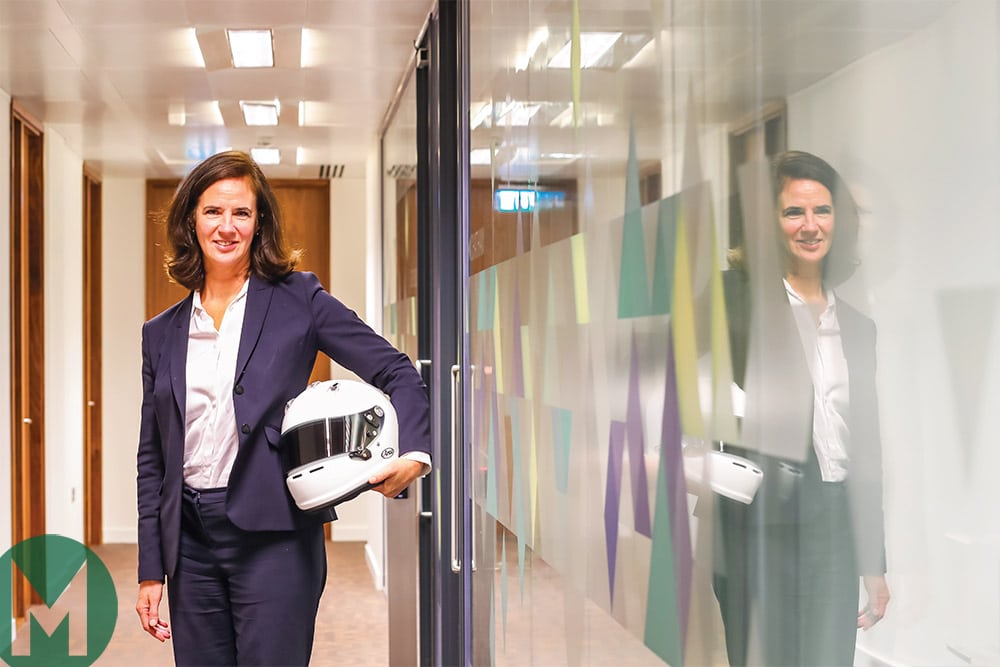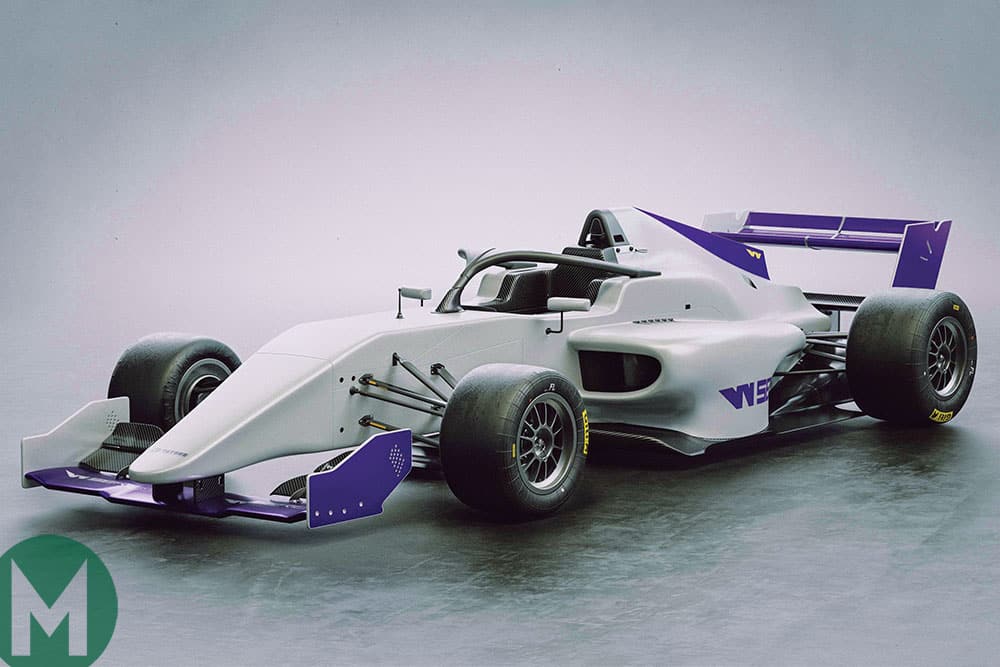W Series: Just don't call it the X Factor
There was a moment at the Autosport Awards late last year that took most of the gathered dignitaries by surprise. Amid the prize-giving to stars of the track and industry back-slapping that accompanies the self-styled ‘Oscars of motor sport’, the hosts introduced a woman of whom few were aware.
Her name was Catherine Bond Muir, a 50-year-old corporate finance lawyer, and she stood in front of a black and white sea of tuxedoed men in a dramatic feathered dress. Muir is the chief executive and business brains behind one of the most radical ideas to hit our sport in recent memory: an all-female racing championship called W Series, which has succeeded not only in putting women-only motor sport on the map, but also in dividing opinion in a way not seen since the heady days of the first Halo.
Muir greeted the gathered crowd before introducing her table, which included racers such as Alice Powell and Shea Holbrook as well as TV personality Vicki Butler-Henderson. “It’s the first all-female table in the history of these awards,” beamed Muir to surprised applause from the audience.
It was a bold stunt and bravura performance by Muir, but one that is coming to typify her new organisation.
We meet a few days before the awards, for her first proper interview – “I don’t want to be the face of this,” she exclaims loudly at one point. “I’m not a front-of-camera person, we have others for that!”

That much is true: W Series has grabbed people’s attention not just because of its concept but because of the blockbuster names it has managed to attract. It is being backed by among others, David Coulthard, Adrian Newey and ex-McLaren F1 man Dave Ryan; talent that has forced even the most jaded and cynical of observers to sit up and take it seriously.
The concept is pretty simple. The new series hopes to attract between 18-20 of the world’s leading female racing drivers to compete for a $1.5m (£1.18m) prize fund. The winner gets $500,000, the rest share the leftovers. As the support series for DTM it will feature 30-minute races at circuits across Europe, including Brands Hatch in the UK, and will use identical Tatuus F3-spec cars, powered by 1.8-litre turbocharged engines.
“We did explore other types of cars,” says Muir. “We went a long way down the line with a different car that is coming later this year. It was more powerful and came with an engine that you could tune up or tune down. And we may still do that. But it didn’t work out. Dave Ryan said: ‘Can we find 18 drivers who can drive these cars safely?’ We took the view that it would be difficult to get 18 drivers who could do that. So it was his call to go for the F3 cars.”
An educated guess suggests that the car she is talking about may be the new Australian S5000 car made by Ligier Crawford, which is due to run a V8 engine, but neither her nor the PR man are willing to name names.
The new W Series will use a Formula 3-spec Tatuus chassis with around 270bhp
THE STATED AIM of the series is to bypass a perceived glass ceiling that women drivers face on the conventional career ladder up through the various championships. Instead of bowing out through lack of support or sponsorship once they reach a certain level women can take part in W Series, hone their skills, then graduate to senior series such as FIA F3 and beyond. It is an idea that has led to criticism (not least from some existing women drivers) for treating women differently. You can sense that the strident Muir is the equal to the arguments, and indeed looks a little crestfallen when told that we are not going to get into that well-aired debate about the series’ merits today. “I like the debate she says,” she says, “it keeps people talking about us.”
The operation is run out of serviced offices in Victoria populated by other young start-ups and complete with brightly coloured sofas and bowls of sweets in the communal areas. But according to Muir it has been a slog getting here since the idea was first born in 2015.
“I have no motor sport background at all. I used to be solicitor specialising in sport and then a corporate financier specialising in sport and leisure deals. I was having a coffee with two friends who talked about F1 and I thought, ‘Oh that’s a very interesting idea because even I know that motor sport is one of the sports where women can compete equally’.
“I’d had a baby at 45 and had historically worked very hard so I was taking time off because I was an older mother, and the question of a female race series coincided with me feeling I was getting a bit bored here. It was an idea that wouldn’t go away.”
She set about drawing up a business plan and gained backing from Sean Wadsworth, the founder of a recruitment business, who is thought to have invested £20m in the venture. “Money was the big thing. It always was. From coming up with the idea myself to begin with to becoming a fully fledged business plan, which was sufficiently complete and compelling that someone would want to put the money in was a challenge.
“Everyone says, ‘too early stage, too early stage’. Ultimately, Sean put the initial money in – that is a leap of faith that you have to take. We set this office up last December and have been working for a year to get to this point.”
The series has just announced the names of its first group of 55 listed drivers. These include former Lotus F1 test driver and FIA women in motor sport ambassador Carmen Jorda, former GP3 drivers Alice Powell and Samin Gómez and British GT class champion Jamie Chadwick. There are also some relative unknowns from around the world including America, China, India and even Kazakhstan.

The initial 55 will be whittled down to 18 (plus two reserves) who will compete for the prize money. Each driver will have to earn her place on the grid, via a variety of pre-selection programmes. Gender aside, this is one of the most interesting areas of the series – and also potentially its biggest weakness.
A KEY PART of Muir’s business plan focuses on the selection process – although there is some debate about how to frame it. “I say it will be like the X-Factor, but others look down their noses at that and prefer to compare it to the Great British Bake Off. The fact is that it will be a reality format based on us picking the final drivers that ultimately get onto the grid.”
Alexander Wurz, the former F1 driver and chairman of the Grand Prix Drivers’ Association, will lead the panel of judges along with Coulthard and Ryan. It is a neat idea, but does it run the risk of undermining the series’ desire to be taken seriously in sporting circles?
On the W Series Company House record it lists the nature of its business as television programme distribution as well as sports. Muir talks excitedly about its drivers having “fantastic back stories” and says future discussions with Coulthard’s Whisper TV production company are on the table. “We haven’t concluded any media deal yet, but it will be recorded for social media, so even if we don’t get a broadcast deal – which we think it will – it will certainly be shown on a digital platform.”
She is aware of the potential pitfalls of making the racing series anything other than pure sport, however. “I think we are about entertaining an audience and informing an audience – right up until the point where the cars go. Then we are a pure sport. We are all about sporting integrity. We are not WWE wrestling and fusing entertainment and sport, we are a sporting brand. But we are competing against all the other sports in the world, from a standing start. We need to engage the audience emotionally from the start.”
She has a point, and to be fair, she draws the line at asking the public to vote: the final decision she insists will be down to the judging panel; meaning it is not a popularity contest.
WHAT WOULD MUIR REGARD AS SUCCESS FOR THE W SERIES? “A FEMALE F1 WORLD CHAMPION”, SHE SAYS WITHOUT HESITATION
“The selection process and judgment will be 90 per cent about speed,” she says. “The reason it won’t be 100 per cent is because someone might do a crazily dangerous lap but manage not to go off and post a good time. But that won’t be enough. Dave Ryan is clear that this has to be about potential.”
W Series is not only ground-breaking because of being female only, but also because it is paying for everything. It is the series itself, rather than privateer teams, which owns the cars. Maintenance and repairs will be the responsibility of technicians hired by the organisers, and every car will run on the same tyres, fuel and oil. It is aimed at banishing the inequalities between teams that can plague other spec-racing series and there is even the possibility that cars will be swapped around during the season to make sure no one can blame the machinery.
“We are taking away that evil of motor racing: money,” says Muir. “It’s what has led to it becoming increasingly a rich boy’s sport. Some really good-quality drivers have come to us because finally they can afford to race.”
W Series is, of course, a business itself and as such needs to make money. It aims to do this by selling sponsorship of the cars and teams to businesses as well as TV rights. “We have had initial discussions with lots of sponsors, including some traditional sponsors but we haven’t gone in hard with any sponsor yet until we tie down our media deal, which is to be announced.
“We will have major sponsors who cover the whole series and appear on all the cars, and we are now also in process of agreeing how we might create artificial teams – we may have six teams of three, or nine teams of two.” That way sponsors can back individual cars and drivers, but will also create more tension and competition on and off track. This is seen as crucial to the success of the series. “It’s all about creating more stories so that we can get the drivers to interact with each other.”
To begin with all the sponsorship money goes to the organisers, but Muir says she is open to the idea of sharing the proceeds in time. “It is going to take a period of time before we become cashflow-positive. But once we become profitable we will have a pot that the drivers can share.” She anticipates reaching profitability in year three.
W Series says it will not retain a financial interest in any driver who graduates to other more conventional championships.
OUR TIME IS UP, and Muir is gamely keen to have her photo taken with a crash helmet we brought along with us. How has she found working with racing people as an outsider and a woman?
“It’s been a pleasant surprise,” she says. “But then I have two older brothers and I worked in finance, and motor sport and the City are not dissimilar. There are parallels. But because of my background I have never had a problem with rooms full of men. If I am trying to raise money I get on and do that. I don’t see myself as a woman, I just don’t care.”
And what would she regard as success for her revolutionary series? “A female F1 world champion,” she says without hesitation.
“It may take many years. It took Lewis Hamilton six years [from his first Formula Renault season] and he had the fast track, so it may be that it is one of the younger drivers who makes it to F1 rather than one of the more experienced drivers. But let’s wait and see.”

